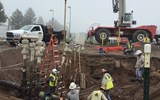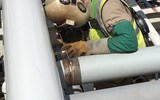1. SAFETY PHILOSOPHY
For over 70 years, our goal at Midwestern Contractors (MWC) has been to create a culture in which employees “live” quality and safety in all of their actions—where they are passionate about quality and safety as a personal value rather than simply obeying an edict from a higher level of authority. An environment in which employees not only follow HSE guidelines but also consistently see others taking safety-focused actions, hear others talking about safety, and feel safety all around them. It is something that we take seriously. It is at the heart of what we do every day. And, to a large degree, these efforts have been very successful. Each year we face new challenges. We are proud, however, of our ability over the decades to address those challenges. Our goal is the elimination of all accidents and incidents. This can only be achieved by fostering a living and breathing safety culture.
2. SAFETY CULTURE
How are positive safety cultures developed? It starts with maintaining a leadership emphasis on quality and safety. Even when ownership and management have the best intentions, there are sometimes gaps between what they say and what they do. As a result, employees get mixed messages about whether safety is truly important. In order to continue to nurture and grow a culture of quality and safety, the field employees must see and hear it being lived by everyone. It is also imperative that peer involvement is encouraged. Expectations must be clearly communicated among management and the entire crew. We have developed several methods for employees to provide real time feedback on each project. Finally, zero accidents and incidents can only be attained through increasing employee ownership and empowerment. Structures and incentives are in place to allow for all employees to participate in the success of their own projects.
3. SAFETY ANALYTICS
Our safety policies and programs are designed to prevent accidents and incidents. To do this we have to ensure our policies are compliant with regulatory requirements and internal directives.
We have four safety managers, and one Certified Safety Professionals, (CSP), they are responsible for making sure employees receive proper training in the right sequence and at the right time. Their responsibility continues by verifying the effectiveness of training in field applications. As well as audits field coaching.
Cloud computing and our safety management system (SMS) allow us to establish effectiveness, and identify specific reasons for non-compliance. Of course, all inspection, audit and checklist information is submitted through our SMS and generates records. This information produces analytical reports and helps our safety managers become preventative instead of reactive to negative safety trends. The information gathering and reporting is near real time. Trends can be revealed quickly. This allows for intervention before an incident develops. Our data not only identifies those trends but also will identify probable causes for identified non-compliance issues i.e. gap in employee training or lack of clarity within the training program itself.
No program is perfect. The tendency for workers to become complacent is a factor to be recognized and dealt with on a daily basis. Without a foundation of belief and a philosophy of trust, our employees would not reach the safety performance levels that they have achieved in recent years. Our ability to verify behaviors, with the goal of continued improvement is essential for the safety of our employees and growth of our safety program.
4. SAFETY TRAINING
At MWC training is a vital part of meeting regulatory requirements. It is how we educate and equip our employees with the right attitudes and skills for safe work. We believe that having a highly educated workforce prevents injuries and incidents, and improves productivity. Our staff includes a Certified Instructional Trainer (CIT). Our CIT designs, develops and delivers training on HSSE for adult learners.
The expense of training reduces lost time injuries, prevents serious injuries, and increases customer confidence in our ability to deliver a project safely.
All employees are required to meet the training requirements defined by their category of experience. We have developed three training brackets, with the goal of providing the highest amount of safety awareness possible. :
- Short Service Employee (SSE)
- Seasoned Employee
- Supervisory Employee
Short Service Employees (SSE) are employees with less than 6 months or less of employment. Statistically SSEs are at a greater risk of being involved with an accident/incident. Because of this correlation our SSE training is developed to provide training coupled with a peer mentor. All SSEs will be required to complete our in-person company orientation process that include the following MWC safety expectations:
- Incident reporting
- Fire prevention training
- Ergonomics
- Stop work authority
- Trade specific roles and responsibilities
- Permitting requirements
- Project specific customer safety requirements and expectations
Each SSE will be assigned a peer mentor to work with, the mentor’s main responsibility is to ensure the SSE does not get hurt or cause an incident. This is completed by working alongside and observing the SSE execute specific tasks. The mentor will intervene when needed and provide feedback to the SSE on application of regulatory, customer and MWC requirements.
Seasoned Employees have maintained employment with MWC for six months or longer. Every seasoned employee will complete safety training annually. Annual training is a multi-week combination of instructor lead and computer training to ensure our workforce meets all regulatory requirements based on our historical and anticipated scope of work. This includes but is not limited to:
- Competent person excavation
- Authorized gas testing
- HAZWOPER
- OSHA 10 & 30
- Hazard communication
- Qualified rigger
- SSE mentor training
- Respirator medical clearance / fit testing
- Confined space
MWC has also instituted a continued training program to ensure qualifications do not lapse throughout the year. Understanding that employees have different skill and training levels, we are endeavoring to develop a process to identify individual strengths and weaknesses. This will allow us to fine tune our training schedule and target areas of safety training that need improvement..
Supervisory employees are responsible for ensuring the safe execution of all work and maintaining compliance with regulatory, customer and MWC specifications. All supervisors will receive the same training as a seasoned employee with additional training focused on; incident reporting and investigation, midwestern code of ethics, effective communication, safety program documentation and quality program compliance, etc. Our supervisors' training sharpen individual skills, promote the understanding of best practices that keep our job sites safe and efficient.
5. SUMMARY
For many years the holy grail of safety has been the achievement of zero injuries. To our knowledge, no company has achieved this. The quest to make this a reality has yielded a treasure trove of knowledge that can be applied to minimize accidents and injuries. We take safety very seriously. In spite of the dangerous environments that our crews are subjected to, we have achieved long periods interrupted with only minor injuries. We will continue the quest for zero injuries because a person that believes in safety on the job, will believe in safety off the job. This belief has the potential to improve the lives of our employees and their families.
Project Gallery
Case Studies















